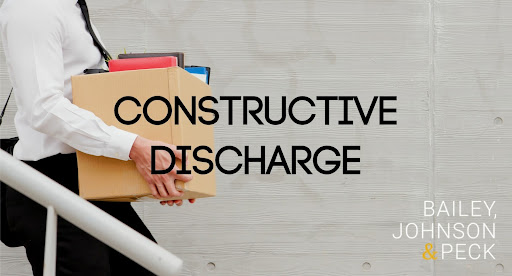Many jobs are stressful and unpleasant in some ways, but many of us push onward anyway. Unfortunately, many Americans suffer intolerable working conditions at their jobs, which forces them to quit to preserve their physical and mental health. Albany employment lawyers at Bailey, Johnson & Peck want to fight for Americans enduring this impossible situation. We can help you go over your Albany employment agreement, compile evidence, and build a strong case to ensure you receive the compensation you deserve. For more information on how our Albany employment and labor lawyers can help you following a constructive discharge, contact 518-456-0082.
What is Constructive Discharge?
Constructive discharge, also known as constructive dismissal or constructive termination, is when an employee is forced to resign from their job due to intolerable working conditions.
What is the Difference Between Wrongful Discharge and Constructive Discharge?
Wrongful termination is different from constructive discharge. Wrongful termination happens when a boss fires an employee for illegal reasons. For example, the boss may fire the employee because they:
- Exposed the boss’s violation of federal or state law
- Belonging to a specific race, gender, sexuality, national origin, religion, etc.
- Complained of hostile or unhealthy working conditions
- Complained of sexual harassment or assault in the workplace
Our Albany workplace sexual harassment attorneys will handle your case with discretion and care.
Constructive Dismissal Examples
An employee may voluntarily quit for a variety of reasons. For example, the employee may have been compelled to resign because they:
- Were actively suffering discrimination at work,
- Were actively suffering harassment at work,
- Received a pay decrease that was unrelated to their work performance,
- Were generally suffering mistreatment either from their boss, their coworkers, their company, or all of the above.
Sometimes, employers purposely create intolerable working conditions and mistreat their employees in hopes that they will quit.
Is Constructive Discharge Legal?
There is not one employment law or legal concept in the United States that protects employees from constructive dismissal. But depending on the facts of each case, constructive dismissal can violate the following legislations in the United States:
- The Fair Labor Standards Act of 1938 determines overtime pay, minimum wage, record keeping, and youth employment standards.
- Equal Pay Act of 1963 states that every employee, regardless of gender, should receive equal pay.
- Title VII of the Civil Rights Act of 1964 states that every employee, regardless of color, race, national origin, gender, or religion, should receive equal treatment.
- Age Discrimination in Employment Act of 1967 states that every employee who is 40 years old and older should receive equal treatment.
- Americans With Disabilities Act of 1990 protects Americans with disabilities from mistreatment and discrimination at their jobs.
- Family and Medical Leave Act of 1993 protects employees who must take unpaid leave for various family and health reasons. Additionally, this act allows the employee to come back to their job when their family or health issue has been resolved.
- Genetic Information Nondiscrimination Act of 2008 states that every employee, regardless of genetic information, shouldn’t suffer discrimination or harassment at their job.
How to File a Constructive Discharge Lawsuit in New York
If you were recently constructively discharged due to a hostile work environment and you want to sue your boss or company, you first need to file a constructive discharge claim with the Equal Employment Opportunity Commission (EEOC). Once you file a claim, the EEOC will investigate your employer’s conduct or your working conditions. After the investigation, you will receive a Notice of a Right to Sue Letter. If you want to skip ahead in the constructive discharge claim process, you can simply request a Notice of a Right to Sue Letter from the EEOC. Upon receiving the Notice of a Right to Sue Letter from the EEOC, the employee must file a lawsuit within 90 days. If they don’t file within 90 days, their case will be dismissed.
When Can I File a Constructive Discharge Claim in New York?
If you’re interested in filing a claim with the EEOC, you must do so in a timely manner. Employees who were constructively dismissed from a business that wasn’t controlled by the government (also called private sector employees) must file a claim with the EEOC within 180 days of their resignation. Meanwhile, federal employees must file a claim with the EEOC within 45 days of their resignation. Generally, the most successful claims and lawsuits are those filed immediately upon resignation.
Constructive Discharge Elements
If an employee quits, they can’t just claim it was due to egregious conduct and intolerable working conditions. They have to have an extensive history to back their claims. Generally, employees must prove the following factors in order to create a strong case:
- The specific details regarding the employer’s illegal conduct
- How long it took for the employee to resign after the employer’s illegal conduct
- Whether or not the employer asked or forced the employee to engage in illegal conduct
- Whether or not the employer actually recognized and investigated the employee’s grievance
A court will also consider something called a “reasonable person standard.” This means that if a reasonable person would generally determine their work environment as hostile, egregious, or intolerable, then their claim will be treated more as constructive termination. However, if a reasonable person wouldn’t find their work environment as hostile, egregious, or intolerable, then their claim will be treated as a voluntary resignation and nothing more.
An employer’s knowledge of intolerable working conditions is also crucial in proving a constructive discharge claim. Basically, an employee must show that their employer knew about the hostile work environment or that the employer intended to create the hostile work environment. Generally, an employer’s knowledge of poor actions or working conditions will come from an employee’s complaint to HR. If the employee doesn’t submit a formal complaint in order to give their boss a chance for improvement, then the employee’s entire claim will weaken.
How to Prove Constructive Discharge in Lawsuit
When it comes to proving egregious conduct or a hostile work environment, it’s important to remember that the law does not require a boss or a job to create a completely stress-free workplace. Nor are they required to treat employees fairly. They are, however, required by law to not engage in or allow issues like discrimination.
In order to have the strongest case possible, you need to have extensive documentation of illegal conduct at your place of employment. This could include pictures, videos, detailed documentation in a journal or a Word document, witness statements, work emails, pay stubs, and more. The more solid evidence you have to justify your claims, the better.
Constructive Dismissal Compensation in New York
If a constructively discharged employee wins their lawsuit, they could receive many types of monetary benefits depending on the facts of their case. More specifically, they could receive:
- Lost Wages from the time of their resignation to the start of their lawsuit.
- Front Pay, which will compensate the victim during their lawsuit and while they remain unemployed.
- Lost Benefits that the employee suffered from their resignation and unemployment.
- Pain and Suffering as a result of unemployment, discrimination, harassment, violence, or other illegal activity that happened at their job.
- Injunctive Relief, which means that the court orders the employer to allow the employee to return to their job with the same pay and benefits as before. The court would also prohibit the employer from committing the same actions that ultimately led to the lawsuit.
- Attorney’s Fees that the employee suffered as a result of the lawsuit.
- Punitive Damages, which more exist to punish the employer rather than compensate the employee.
Maximum Compensation for Constructive Dismissal
The EEOC enforces compensation limits based on the size of the company or business in question. The limits are as follows:
- $50,000 for businesses that have 15 to 100 employees
- $100,000 for businesses that have 101 to 200 employees
- $200,000 for businesses that have 201 to 500 employees
- $300,000 for businesses that have more than 500 employees
Likelihood of Winning a Constructive Termination Lawsuit

The reality is that very few employees will file a lawsuit like this, and even fewer will win their lawsuits. This is because lawsuits are obviously very expensive and can last months or years. Additionally, it’s incredibly hard for an employee to prove that they experienced constructive discharged at their job. That’s why it’s important to contact an Albany employment attorney at Bailey, Johnson & Peck before you’re forced to resign. We can help you determine if you have a strong case against your employer or company. If you want to proceed with your lawsuit, we will help you gather evidence and build the strongest case possible.
Experienced Labor and Employment Attorneys in Albany, NY
Unfortunately, many Americans face the impossible decision of staying at a job with intolerable working conditions or quitting and wondering whether they can feed their families. Unfair circumstances like this motivate lawyers at Bailey, Johnson & Peck to provide our clients with the justice they deserve. For more legal advice, call a lawyer today at 518-456-0082. We will take care of you and your constructive dismissal.




